Patrick Doherty has recently made a major investment in his sheep housing facilities in Co Donegal to make life easier when working full-time off the farm.
Patrick keeps a flock of 110 mountain-type ewes which up to this year would be outwintered on the hills. This involved a considerable amount of daily labour when it came to feeding and lambing ewes.
The first batch of ewes went through the shed last year with a massive difference in the labour required.
“We don’t know ourselves. We went from having an old shed that could only hold 30 ewes at a time which meant we tried to stagger lambing. It felt like lambing was going on forever,” Patrick explained.
He continued: “For many farmers, full-time farming is no longer a viable option and having good facilities is essential to make it possible to continue part-time farming. For me, the main driver in making the decision to upgrade the sheep housing was the reduced labour required. Improving flock and grass management was also important.”
A suckler herd is also kept on the farm, so alongside the sheep shed a cattle handling unit was constructed. “Health and safety was also a major concern and fed into the desire to construct this shed and handling unit. It will also reduce the need to move cattle across a public road,” Patrick outlined.
Pictures one to four
The shed is an A-roof design with slatted pens running down the centre of the shed. Individual lambing pens line one side of the shed, while the other side holds an impressive handling unit.
“With the new shed now we can get ewes in early depending on the weather and save the fields for the springtime for lambs and ewes to get out,” Patrick said.
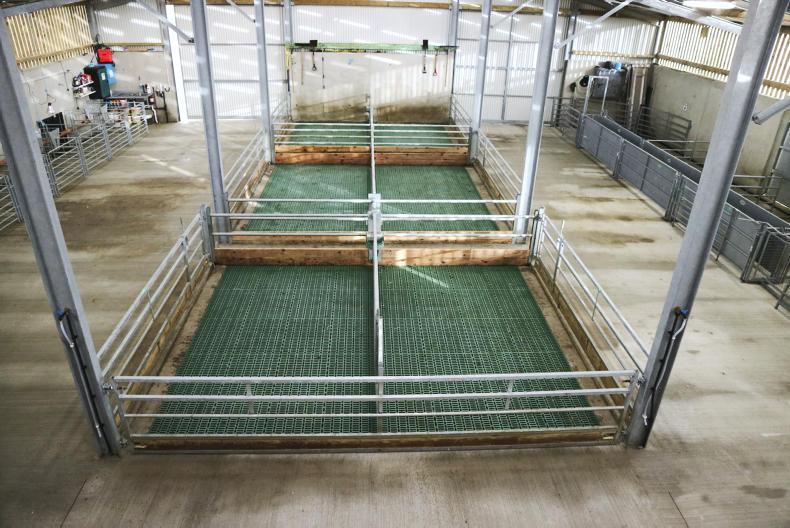
Picture one.
“In terms of reducing labour combined with the low availability of straw in this part of the world, then the best option was to go with slats.”
The shed is four bays, or 19.2m long with three slatted pens. Slatted pens have a span of 5.3m, with 5m slats, over a 4.7m-wide tank, fitted with a spine wall down the middle. The pens have been split to make management easier.
The middle pen is 4.8m-wide, while the two pens either side are 4.2m wide as each have a 600mm wide walkthrough trough in place.
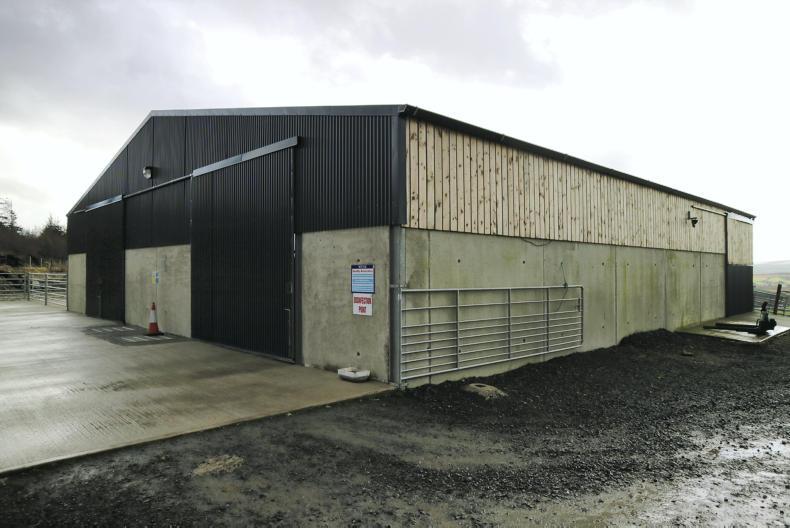
Picture two.
The layout means that two pens have feeding space on all four sides while the remaining pen has feeding on three sides. This ensures there are no issues when it comes to feeding meal to all ewes at once.

Picture three.
The total pen space is 70m2, while there is 52.9m of feed space available. Mountain type ewes with a bodyweight of approximately 50kg require 1m2/ewe on slats, or 0.8m2 if they are shorn prior to housing.
The tank itself is 1.8m deep and 20.7m long with total capacity of approximately 165m3, again more than enough for this size of a flock. “The tank is bigger than we will need but it does add capacity to the whole farm,” Patrick explained.

Picture four.
Generally, tanks on sheep sheds would only be 1.2m deep.
Pictures five and six
There are 10 individual lambing pens in the shed, measuring 1.4m by 1.7m.

Picture five.
To the back of the pen is a channel which is piped to the slatted tank.
This helps to keep bedding in pens dry. Water is supplied by a large pipe running along the back wall which has a ballcock fitted to it at one end.
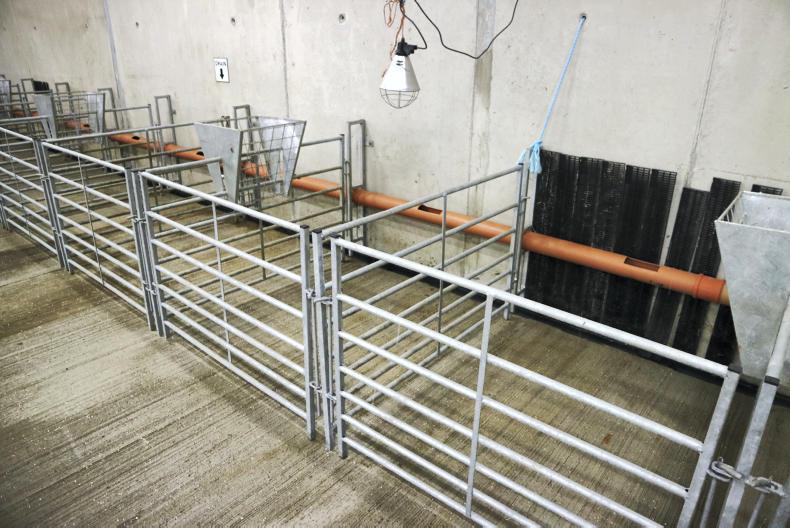
Picture six.
There are slots cut in the top of the pipe in each pen. This pipe can be drained at the centre. All plumbing was completed by Patrick himself.
Picture seven
Hay racks are located between every two pens. There is also an impressive sink and storage area in a corner beside the lambing pens to ensure everything is close to hand at lambing.
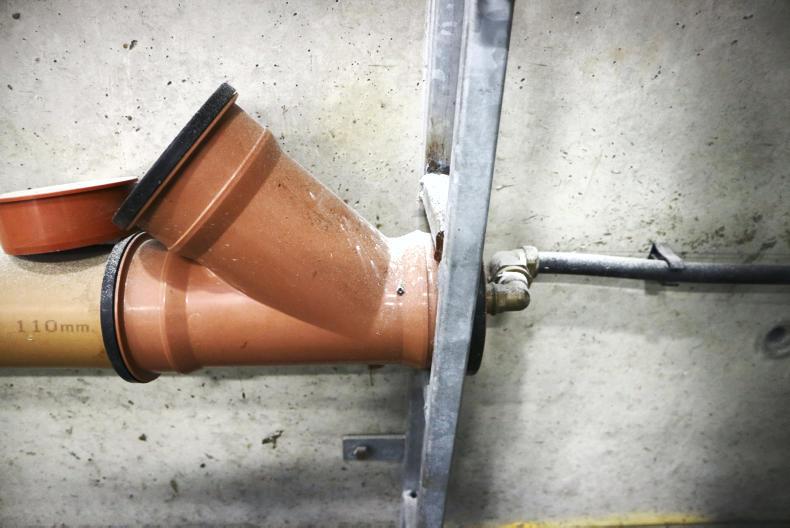
Picture seven.
The final addition that is to be made is to install a small water heater for the shed.
Picture eight
The other side of the shed is fitted with a handling unit. This is in place during the winter months and can be removed and replaced with penning, if desired. A channel runs along this side of the shed also, which feeds into the slatted tank. The handling unit is made up of four pens which run beside the race.
Doors along the wall provide access to the outside handling unit, so that batches of ewes can be moved through the unit without dirtying the rest of the shed.
Ventilation is critical when designing a livestock shed.
While spaced sheeting in the roof was not the original plan, due to planning concerns it was the design that was decided on. Due to the width of the shed, if vented sheeting had been used, it would have meant that a gap would need to be left under the eaves to provide inlet ventilation.
However, due to the exposed site, this would not work so spaced boarding was installed along both sides of the shed instead.
While a gap running under the eaves of a shed provides a very good source of inlet ventilation, it is very location-dependent and highlights that a one-cap-fits-all approach does not work for ventilation.
Site exposure, building geometry and the prevailing wind direction are all site-specific.
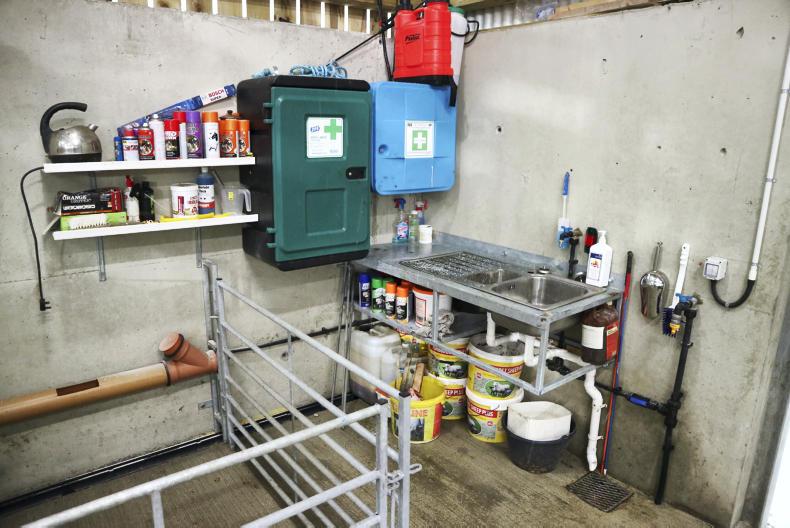
Picture eight.
In general, the roof slope of all A-roof livestock buildings built through TAMS must be a minimum of 15 degrees.
However, where a spaced roof is installed throughout the entire roof then a slope of 12 degrees can be built, as was done here.
The sheeting is installed at gaps of 20mm.
“Ideally, we would have gone with a 15-degree slope but we were afraid that it would push the apex too high and we would have difficulties getting planning permission due to the location,” Patrick explained.
Costs
The total cost of the shed and outside handling unit came to approximately €89,000 including VAT.
This includes a large area of auxiliary concrete to the front of the shed.
The VAT element, which has been claimed back, was worth €11,500, while the TAMS grant aid amounted to €46,000. This leaves the net cost of the shed at €31,500.
Mark McConnell, agricultural consultant from Stranorlar, Co Donegal, completed the TAMS application and payment claim for the project.
“If it wasn’t for being able to get a 60% grant through the young farmer element of TAMS then the shed would never have been built,” Patrick explained.
“Mark and his team put in a lot of work before the application was made and was extremely careful which made the payment claim straightforward.”
All penning for the project was supplied by Carn Agri Products, while Charlie Doherty of the company was also influential when it came to the layout and design of the shed. Michael Friel from Creeslough, Co Donegal, was the architect for the shed.
“There is a lot of space around the shed but that is something I wanted, if down the line I were to use a diet feeder, for example,” Patrick said.
The shed was supplied by Greenhill Engineering while the concrete work was completed by Rodney Black. John Harley did the electrical work while Cathal Moy Plant Hire completed the groundwork.
Concrete
Letterkenny Concrete & Quarry Products Ltd provided all the concrete required for the project while Churchill Stone Ltd provided the aggregate.
Charles Kelly Ltd provided drainage and plumbing supplies.
Patrick also acknowledges the technical support and advice offered from local Department of Agriculture offices and the TAMS section of the Dept of Agriculture stand at the 2016 National Ploughing Championships.

An impressive handling unit was also constructed adjoining the sheep shed. This unit is used for both sheep and cattle with gates with six bars chosen. Full plans and video will be online over the weekend.
Patrick Doherty has recently made a major investment in his sheep housing facilities in Co Donegal to make life easier when working full-time off the farm.
Patrick keeps a flock of 110 mountain-type ewes which up to this year would be outwintered on the hills. This involved a considerable amount of daily labour when it came to feeding and lambing ewes.
The first batch of ewes went through the shed last year with a massive difference in the labour required.
“We don’t know ourselves. We went from having an old shed that could only hold 30 ewes at a time which meant we tried to stagger lambing. It felt like lambing was going on forever,” Patrick explained.
He continued: “For many farmers, full-time farming is no longer a viable option and having good facilities is essential to make it possible to continue part-time farming. For me, the main driver in making the decision to upgrade the sheep housing was the reduced labour required. Improving flock and grass management was also important.”
A suckler herd is also kept on the farm, so alongside the sheep shed a cattle handling unit was constructed. “Health and safety was also a major concern and fed into the desire to construct this shed and handling unit. It will also reduce the need to move cattle across a public road,” Patrick outlined.
Pictures one to four
The shed is an A-roof design with slatted pens running down the centre of the shed. Individual lambing pens line one side of the shed, while the other side holds an impressive handling unit.
“With the new shed now we can get ewes in early depending on the weather and save the fields for the springtime for lambs and ewes to get out,” Patrick said.

Picture one.
“In terms of reducing labour combined with the low availability of straw in this part of the world, then the best option was to go with slats.”
The shed is four bays, or 19.2m long with three slatted pens. Slatted pens have a span of 5.3m, with 5m slats, over a 4.7m-wide tank, fitted with a spine wall down the middle. The pens have been split to make management easier.
The middle pen is 4.8m-wide, while the two pens either side are 4.2m wide as each have a 600mm wide walkthrough trough in place.

Picture two.
The layout means that two pens have feeding space on all four sides while the remaining pen has feeding on three sides. This ensures there are no issues when it comes to feeding meal to all ewes at once.

Picture three.
The total pen space is 70m2, while there is 52.9m of feed space available. Mountain type ewes with a bodyweight of approximately 50kg require 1m2/ewe on slats, or 0.8m2 if they are shorn prior to housing.
The tank itself is 1.8m deep and 20.7m long with total capacity of approximately 165m3, again more than enough for this size of a flock. “The tank is bigger than we will need but it does add capacity to the whole farm,” Patrick explained.

Picture four.
Generally, tanks on sheep sheds would only be 1.2m deep.
Pictures five and six
There are 10 individual lambing pens in the shed, measuring 1.4m by 1.7m.

Picture five.
To the back of the pen is a channel which is piped to the slatted tank.
This helps to keep bedding in pens dry. Water is supplied by a large pipe running along the back wall which has a ballcock fitted to it at one end.

Picture six.
There are slots cut in the top of the pipe in each pen. This pipe can be drained at the centre. All plumbing was completed by Patrick himself.
Picture seven
Hay racks are located between every two pens. There is also an impressive sink and storage area in a corner beside the lambing pens to ensure everything is close to hand at lambing.

Picture seven.
The final addition that is to be made is to install a small water heater for the shed.
Picture eight
The other side of the shed is fitted with a handling unit. This is in place during the winter months and can be removed and replaced with penning, if desired. A channel runs along this side of the shed also, which feeds into the slatted tank. The handling unit is made up of four pens which run beside the race.
Doors along the wall provide access to the outside handling unit, so that batches of ewes can be moved through the unit without dirtying the rest of the shed.
Ventilation is critical when designing a livestock shed.
While spaced sheeting in the roof was not the original plan, due to planning concerns it was the design that was decided on. Due to the width of the shed, if vented sheeting had been used, it would have meant that a gap would need to be left under the eaves to provide inlet ventilation.
However, due to the exposed site, this would not work so spaced boarding was installed along both sides of the shed instead.
While a gap running under the eaves of a shed provides a very good source of inlet ventilation, it is very location-dependent and highlights that a one-cap-fits-all approach does not work for ventilation.
Site exposure, building geometry and the prevailing wind direction are all site-specific.

Picture eight.
In general, the roof slope of all A-roof livestock buildings built through TAMS must be a minimum of 15 degrees.
However, where a spaced roof is installed throughout the entire roof then a slope of 12 degrees can be built, as was done here.
The sheeting is installed at gaps of 20mm.
“Ideally, we would have gone with a 15-degree slope but we were afraid that it would push the apex too high and we would have difficulties getting planning permission due to the location,” Patrick explained.
Costs
The total cost of the shed and outside handling unit came to approximately €89,000 including VAT.
This includes a large area of auxiliary concrete to the front of the shed.
The VAT element, which has been claimed back, was worth €11,500, while the TAMS grant aid amounted to €46,000. This leaves the net cost of the shed at €31,500.
Mark McConnell, agricultural consultant from Stranorlar, Co Donegal, completed the TAMS application and payment claim for the project.
“If it wasn’t for being able to get a 60% grant through the young farmer element of TAMS then the shed would never have been built,” Patrick explained.
“Mark and his team put in a lot of work before the application was made and was extremely careful which made the payment claim straightforward.”
All penning for the project was supplied by Carn Agri Products, while Charlie Doherty of the company was also influential when it came to the layout and design of the shed. Michael Friel from Creeslough, Co Donegal, was the architect for the shed.
“There is a lot of space around the shed but that is something I wanted, if down the line I were to use a diet feeder, for example,” Patrick said.
The shed was supplied by Greenhill Engineering while the concrete work was completed by Rodney Black. John Harley did the electrical work while Cathal Moy Plant Hire completed the groundwork.
Concrete
Letterkenny Concrete & Quarry Products Ltd provided all the concrete required for the project while Churchill Stone Ltd provided the aggregate.
Charles Kelly Ltd provided drainage and plumbing supplies.
Patrick also acknowledges the technical support and advice offered from local Department of Agriculture offices and the TAMS section of the Dept of Agriculture stand at the 2016 National Ploughing Championships.

An impressive handling unit was also constructed adjoining the sheep shed. This unit is used for both sheep and cattle with gates with six bars chosen. Full plans and video will be online over the weekend.















 This is a subscriber-only article
This is a subscriber-only article











SHARING OPTIONS: